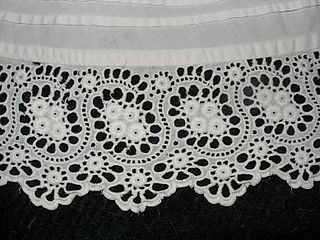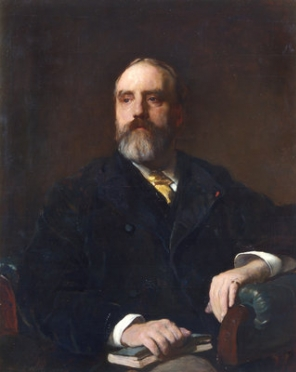
Crochet is a process of creating textiles by using a crochet hook to interlock loops of yarn, thread, or strands of other materials. The name is derived from the French term crochet, which means 'hook'. Hooks can be made from different materials, sizes, and types. The key difference between crochet and knitting, beyond the implements used for their production, is that each stitch in crochet is completed before you begin the next one, while knitting keeps many stitches open at a time. Some variant forms of crochet, such as Tunisian crochet and Broomstick lace, do keep multiple crochet stitches open at a time.

Embroidery is the art of decorating fabric or other materials using a needle to stitch thread or yarn. Embroidery may also incorporate other materials such as pearls, beads, quills, and sequins. In modern days, embroidery is usually seen on hats, clothing, blankets, and handbags. Embroidery is available in a wide variety of thread or yarn colour. It is often used to personalize gifts or clothing items.

A needlework sampler is a piece of embroidery or cross-stitching produced as a 'specimen of achievement', demonstration or a test of skill in needlework. It often includes the alphabet, figures, motifs, decorative borders and sometimes the name of the person who embroidered it and the date. The word sampler is derived from the Latin exemplum, which means 'example'.

Blackwork, sometimes historically termed Spanish blackwork, is a form of embroidery generally worked in black thread, although other colours are also used on occasion, as in scarletwork, where the embroidery is worked in red thread. Most strongly associated with Tudor period England, blackwork typically, though not always, takes the form of a counted-thread embroidery, where the warp and weft yarns of a fabric are counted for the length of each stitch, producing uniform-length stitches and a precise pattern on an even-weave fabric. Blackwork may also take the form of free-stitch embroidery, where the yarns of a fabric are not counted while sewing.

Hardanger embroidery or "Hardangersøm" is a form of embroidery traditionally worked with white thread on white even-weave linen or cloth, using counted thread and drawn thread work techniques. It is sometimes called whitework embroidery.

Drawn thread work is one of the earliest forms of open work embroidery, and has been worked throughout Europe. Originally it was often used for ecclesiastical items and to ornament shrouds. It is a form of counted-thread embroidery based on removing threads from the warp and/or the weft of a piece of even-weave fabric. The remaining threads are grouped or bundled together into a variety of patterns. The more elaborate styles of drawn thread work use a variety of other stitches and techniques, but the drawn thread parts are their most distinctive element. It is also grouped with whitework embroidery because it was traditionally done in white thread on white fabric and is often combined with other whitework techniques.

Berlin wool work is a style of embroidery similar to today's needlepoint that was particularly popular in Europe and America from 1804 to 1875. It is typically executed with wool yarn on canvas, worked in a single stitch such as cross stitch or tent stitch, although Beeton's book of Needlework (1870) describes 15 different stitches for use in Berlin work. It was traditionally stitched in many colours and hues, producing intricate three-dimensional looks by careful shading. Silk or beads were frequently used as highlights. The design of such embroidery was made possible by the great progress made in dyeing, initially with new mordants and chemical dyes, followed in 1856, especially by the discovery of aniline dyes, which produced bright colors.

Lace is a delicate fabric made of yarn or thread in an open weblike pattern, made by machine or by hand. Generally, lace is split into two main categories, needlelace and bobbin lace, although there are other types of lace, such as knitted or crocheted lace. Other laces such as these are considered as a category of their specific craft. Knitted lace, therefore, is an example of knitting. This article considers both needle lace and bobbin lace.

Broderie anglaise is a whitework needlework technique incorporating features of embroidery, cutwork and needle lace that became associated with England, due to its popularity there in the 19th century.

Chikankari is a traditional embroidery style from Lucknow, India. Translated, the word means embroidery, and it is one of Lucknow's best known textile decoration styles. The main market in Lucknow for Chikankari based products is Chowk. Production is mainly based in Lucknow and in the adjoining districts.

Whitework embroidery is any embroidery technique in which the stitch and the foundation fabric are of same color. Styles of whitework embroidery include most drawn thread work, broderie anglaise, Hardanger embroidery, Hedebo embroidery, Mountmellick embroidery, reticella and Schwalm. Whitework embroidery is one of the techniques employed in heirloom sewing for blouses, christening gowns, baby bonnets, and other small articles. It has been used extensively on household and ecclesiastical linen, as decoration. It is often found on traditional regional and national costume, particularly on shirts, aprons and head coverings.

Knitted fabric is a textile that results from knitting, the process of inter-looping of yarns or inter-meshing of loops. Its properties are distinct from woven fabric in that it is more flexible and can be more readily constructed into smaller pieces, making it ideal for socks and hats.

Cutwork or cut work, also known as punto tagliato in Italian, is a needlework technique in which portions of a textile, typically cotton or linen, are cut away and the resulting "hole" is reinforced and filled with embroidery or needle lace.

Buttonhole stitch and the related blanket stitch are hand-sewing stitches used in tailoring, embroidery, and needle lace-making.

The straight or running stitch is the basic stitch in hand-sewing and embroidery, on which all other forms of sewing are based. The stitch is worked by passing the needle in and out of the fabric at a regular distance. All other stitches are created by varying the straight stitch in length, spacing, and direction.

Walter Weldon FRS FRSE was a 19th-century English industrial chemist and journalist. He was President of the Society of Chemical Industry from 1883-84.

Corded quilting is a decorative quilting technique popular from the late 17th through the early 19th centuries. In corded quilting, a fine fabric, sometimes colored silk but more often white linen or cotton, is backed with a loosely woven fabric. Floral or other motifs are outlined in parallel rows of running stitches or backstitches to form channels, and soft cotton cord is inserted through the backing fabric using a blunt needle and drawn along the quilted channels to produce a raised effect. Tiny quilting stitches in closely spaced rows fill the motifs and provide contrast to the corded outlines.

Embroidery was an important art in the Islamic world from the beginning of Islam until the Industrial Revolution disrupted traditional ways of life.

The term Hedebo embroidery covers several forms of white embroidery which originated in the Hedebo (heathland) region of Zealand, Denmark, in the 1760s. The varied techniques which evolved over the next hundred years in the farming community were subsequently developed by the middle classes until around 1820. They were applied to articles of clothing such as collars and cuffs but were also used to decorate bed linen.

Herbert Niebling was a master designer of the style of lace knitting called Kunststricken (art-knitting). Today, his designs remain popular with lace knitting enthusiasts.






















